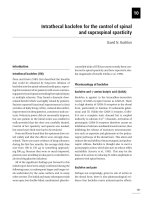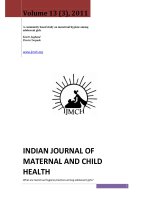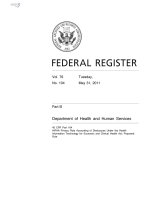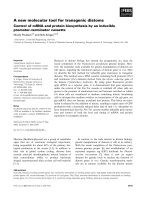ality control of botanicals and botanical health products screening for adulterants and metabolomic investigations
Bạn đang xem bản rút gọn của tài liệu. Xem và tải ngay bản đầy đủ của tài liệu tại đây (1.85 MB, 235 trang )
QUALITY CONTROL OF BOTANICALS AND BOTANICAL
HEALTH PRODUCTS: SCREENING FOR ADULTERANTS
AND METABOLOMIC INVESTIGATIONS
LI LIN
NATIONAL UNIVERSITY OF SINGAPORE
2011
QUALITY CONTROL OF BOTANICALS AND BOTANICAL
HEALTH PRODUCTS: SCREENING FOR ADULTERANTS
AND METABOLOMIC INVESTIGATIONS
LI LIN
(B.Sc., XJTU)
A THESIS SUBMITTED
FOR THE DEGREE OF DOCTOR OF PHILOSOPHY
DEPARTMENT OF PHARMACY
NATIONAL UNIVERSITY OF SINGAPORE
2011
Dedicated to my parents and Vivi
I
ACKNOWLEDGEMENTS
First of all, I would like to express my deepest and most sincere gratitude to my
supervisor Associate Professor Koh Hwee Ling and co-supervisor Professor Bosco
Chen Bloodworth, for their invaluable guidance, patience and kind supervision. Being
their PhD student has been one of the most fortunate moments in my life. In addition, I
would also like to thank Ms Low Min Yong and Dr Ge Xiao Wei from Health Sciences
Authority of Singapore for their extremely generous support and valuable suggestions.
The Department of Pharmacy, NUS and the Health Sciences Authority of
Singapore also deserve very special thanks for the financial support (NUS graduate
research scholarship) and research facilities that make this study possible. I would
specially like to thank Associate Professor Chan Sui Yung, Head of the Department of
Pharmacy, for her understanding and concern during my PhD study. I would like to also
thank the following people whom I had worked with quite closely in NUS and in the
Pharmaceutical laboratory of HSA: Dr Toh Ding Fung, Dr Hou Peiling, Mr Ching
Jianhong, Ms Chay Lai Fong, Ms Teo Hong Gek Jessie, Ms Chin Lee Cheng Agnes, Dr
Tan Jing, Mr Patel Dhavalkumar Narendrabhai, Dr Sogand Zareisedehizadeh, for their
friendship and support. The undergraduate students who had worked with me in these
labs, Miss Fransiska Aliwarga and Miss Ng Ke Ting Chelsea, also deserve big thanks
for their curiosities that stimulated ideas in my research work, as well as for their
helping hands.
Last but not least, I would like to express my most sincere appreciation to my
family for their love, continuous support during this PhD study.
II
LIST OF PUBLICATIONS
1. Li Lin, Low Min-Yong, Aliwarga Fransiska, Teo Jessie, Ge Xiao-Wei, Zeng Yun,
Bloodworth Bosco Chen, Koh Hwee-Ling. Isolation and identification of
hydroxythiohomosildenafil in herbal dietary supplements sold as sexual
performance enhancement products. Food Addit. Contam., 2009, 26(2), 145-151.
2. Li Lin, Low Min-Yong, Ge Xiao-Wei, Bloodworth Bosco Chen, Koh Hwee-Ling.
Isolation and structural elucidation of dapoxetine as an adulterant in a health
supplement used for sexual performance enhancement. J Pharm. Biomed. Anal.,
2009, 50(5), 724-728.
3. Ge Xiaowei, Li Lin, Koh Hwee-Ling, Low Min-Yong. Identification of a new
sildenafil analogue in a health supplement. 2011, 56(3), 491-496.
4. Tan Jing, Li Lin, Zeng Yun, Ge Xiaowei, Low Min-Yong. Characterization of
Chinese Medicines by Comprehensive Two-Dimensional Gas Chromatography and
Time-of-Flight Mass Spectrometry (GC×GC-TOFMS) with Assistance of
Multivariate Data Analyses. Sep. Sci., 2011, 3(2), 5-7.
5. Low Min-Yong, Zeng Yun, Li Lin
, Ge Xiao-Wei, Lee Ruth, Bloodworth Bosco
Chen, Koh Hwee-Ling. Safety and quality assessment of 175 illegal sexual
enhancement products seized in Red-Light districts in Singapore. Drug Saf., 2009,
32(12), 1-6.
6. Ge Xiao-Wei, Low Min-Yong, Zou Peng, Li Lin
, Yin Sharon Oh Sze, Bloodworth
Bosco Chen, Koh Hwee-Ling. Structural elucidation of a PDE-5 inhibitor detected
as an adulterant in a health supplement. J Pharm. Biomed. Anal., 2008, 48(4), 1070-
1075.
III
7. Low Min-Yong, Li Lin, Ge Xiao-Wei, Kee Chee-Leong, Koh Hwee-Ling. Isolation
and structural elucidation of Flibanserin as an adulterant in a health supplement
used for female sexual performance enhancement. J Pharm. Biomed. Anal.,
Accepted.
8. Li Lin, Low Min-Yong, Ge Xiao-Wei, Bloodworth Bosco Chen, Koh Hwee-Ling.
Isolation and structural elucidation of a new sildenafil analogue from a functional
coffee. J Agric. Food Chem., Submitted.
9. Li Lin, Low Min-Yong, Ge Xiao-Wei, Bloodworth Bosco Chen, Koh Hwee-Ling.
Simultaneous determination of 19 phosphodiesterase type-5 inhibitors and
analogues as adulterants in health supplements for sexual performance enhancement
by high performance liquid chromatography-diode array detector. J Chromatogr. A,
Submitted.
10. Li Lin, Low Min-Yong, Ge Xiao-Wei, Bloodworth Bosco Chen, Koh Hwee-Ling. A
Liquid Chromatography-Linear Ion Trap-Orbitrap XL hybrid Fourier Transform
Mass Spectrometry method used for characterizing the variation of Panax
notoginseng extracted with different pressurized liquid extraction procedures. J
Phytochem. Anal., In preparation.
11. Li Lin, Low Min-Yong, Ge Xiao-Wei, Bloodworth Bosco Chen, Koh Hwee-Ling.
Metabolomic investigation of adaptogenic botanicals together with raw and steamed
Panax notoginseng using non-targeted metabolite profiling coupled with
multivariate data analysis approach. J Phytochem. Anal., In preparation.
IV
LIST OF POSTER PRESENTATIONS
1. Li Lin, Low Min-Yong, Ge Xiao-Wei, Bloodworth Bosco Chen, Koh Hwee-Ling.
Metabolomic profiling of three Panax species using pressurized liquid extraction
and LC-LTQ-Orbitrap XL FTMS. Poster presentation, Recent Development in
Chinese Herbal Medicine Conference, 25-26 Jan 2010, Nanyang Technological
University, Singapore (Best poster award).
2. Li Lin, Low Min-Yong, Aliwarga Fransiska, Teo Jessie, Ge Xiao-Wei, Zeng Yun,
Bloodworth Bosco Chen, Koh Hwee-Ling. Identification of a sildenafil analogue in
an internet health supplement. 22nd Federation of Asian Pharmaceutical Association
Congress (FAPA 2008), 7-10 Nov 2008, Grand Copthorne Waterfront Hotel,
Singapore.
3. Li Lin, Low Min-Yong, Ge Xiao-Wei, Bloodworth Bosco Chen, Koh Hwee-Ling.
Metabolomic profiling of three Panax species using pressurized liquid extraction
and LC-LTQ-Orbitrap XL FT MS. Poster presentation, Educating Pharmacists (Asia)
Symposium, 15-16 Apr 2010, National University of Singapore, Singapore.
4. Li Lin
, Low Min-Yong, Ge Xiao-Wei, Bloodworth Bosco Chen, Koh Hwee-Ling.
Metabolomic profiling of three Panax species using pressurized liquid extraction
and LC-LTQ-Orbitrap XL FTMS. Poster presentation, 6th AAPS-NUS Student
Chapter (ANSC) Scientific Symposium, 7 Apr 2010, National University of
Singapore, Singapore.
5. Ng Chelsea, Li Lin
, Ge Xiao-Wei, Low Min-Yong, Koh Hwee-Ling. Authentication
of herbs by plants metabolomics. 5th AAPS-NUS Student Chapter (ANSC)
Scientific Symposium, 1 Apr 2009, National University of Singapore, Singapore.
V
6. Aliwarga Fransiska, Ching Jianhong, Li Lin, Low Min-Yong, Koh Hwee-Ling.
Screening of sexual performance enhancement and slimming products available
fron the Internet for undeclared drugs. 4th AAPS-NUS Student Chapter (ANSC)
Scientific Symposium, 2 Apr 2008, National University of Singapore, Singapore.
VI
TABLE OF CONTENTS
ACKNOWLEDGEMENTS I
LIST OF PUBLICATIONS II
LIST OF POSTER PRESENTATIONS IV
TABLE OF CONTENTS VI
SUMMARY IX
LIST OF TABLES XII
LIST OF FIGURES XIV
LIST OF ABBREVIATIONS AND SYMBOLS XVII
CHAPTER 1 INTRODUCTION 1
1.1 Quality of botanicals and botanical health products 2
1.1.1 Factors affecting the quality 2
1.1.2 Methods and techniques used for quality control 5
1.2 Targeted adulterant screening in botanical health products 16
1.2.1 Sexual performance enhancement products 17
1.2.2 Slimming products 26
1.3 Metabolomic investigations for the quality control of botanicals 29
1.3.1 Selected botanicals for investigation 31
1.3.2 Sample extraction techniques 35
1.3.3 Metabolite fingerprinting 35
1.3.4 Data pre-processing 37
1.3.5 Multivariate data analysis 38
CHAPTER 2 HYPOTHESES AND OBJECTIVES 40
2.1 Hypotheses 40
2.2 Objectives 40
CHAPTER 3 TARGETED ADULTERANT SCREENING IN BOTANICAL
HEALTH PRODUCTS USED FOR SEXUAL PERFORMANCE
ENHANCEMENT AND SLIMMING 42
3.1 HPLC-DAD method development 42
3.1.1 Introduction 42
VII
3.1.2 Objective 44
3.1.3 Experimental 44
3.1.4 Results and discussion 48
3.1.5 Conclusion 54
3.2 Targeted adulterant screening in botanical health products used for sexual
performance enhancement and slimming bought on-line 55
3.2.1 Introduction 55
3.2.2 Objectives 55
3.2.3 Experimental 55
3.2.4 Results and discussion 60
3.2.5 Conclusion 68
CHAPTER 4 ISOLATION, PURIFICATION AND STRUCTURAL
ELUCIDATION OF NEW ADULTERANTS FROM BOTANICAL
HEALTH PRODUCTS USED FOR SEXUAL PERFORMANCE
ENHANCEMENT 69
4.1 Isolation and identification of compound X 69
4.1.1 Introduction 69
4.1.2 Objective 70
4.1.3 Experimental 70
4.1.4 Results and discussion 73
4.1.5 Conclusion 79
4.2 Isolation and structural elucidation of compound Y 80
4.2.1 Introduction 80
4.2.2 Objective 80
4.2.3 Experimental 81
4.2.4 Results and discussion 85
4.2.5 Conclusion 93
4.3 Isolation and structural elucidation of compound Z 94
4.3.1 Introduction 94
4.3.2 Objective 95
4.3.3 Experimental 95
4.3.4 Results and discussion 98
4.3.5 Conclusion 105
VIII
CHAPTER 5 NON-TARGETED METABOLOMIC INVESTIGATIONS OF
BOTANICALS USING LIQUID CHROMATOGRAPHY-LINEAR
ION TRAP-ORBITRAP XL HYBRID FOURIER TRANSFORM
MASS SPECTROMETRY 106
5.1 PLE and LC-LTQ-Orbitrap XL FT MS method development 106
5.1.1 Introduction 106
5.1.2 Objectives 108
5.1.3 Experimental 108
5.1.4 Results and discussion 116
5.1.5 Conclusion 133
5.2 Application of LC-LTQ-Orbitrap XL FT MS for non-targeted
metabolomic investigation of selected herbs 134
5.2.1 Introduction 134
5.2.2 Objective 135
5.2.3 Experimental 135
5.2.4 Results and discussion 140
5.2.5 Conclusion 176
CHAPTER 6 CONCLUSION AND FUTURE WORK 178
6.1 Conclusions 178
6.2 Future work 183
BIBLIOGRAPHY 185
APPENDICES 202
IX
SUMMARY
The work presented in this thesis aims to develop analytical methods and apply
them for the quality control of botanicals and botanical health products. Firstly, for the
quality control of botanical health products used for sexual performance enhancement
and slimming, targeted adulterant screening was carried out using high performance
liquid chromatography-diode array detector (HPLC-DAD), liquid chromatography-
mass spectrometry (LC-MS) and gas chromatography-mass spectrometry (GC-MS).
Secondly, for the quality assessment of adaptogenic botanicals together with raw and
steamed Panax notoginseng, non-targeted metabolite profiling using liquid
chromatography-linear ion trap-Orbitrap XL fourier transform mass spectrometry (LC-
LTQ-Orbitrap XL FT MS) coupled with multivariate data analysis was applied to
commercial samples in Singapore and China.
Undeclared western drugs such as Phosphodiesterase-type 5 (PDE-5) inhibitors
as well as their analogues found in the botanical health product samples have resulted in
severe adverse reactions. Screening for the presence of synthetic drugs illegally added
into botanical health products is important to ensure the quality of botanical health
products and to safeguard the interests and safety of consumers. A new and simple
HPLC-DAD method was developed, optimized and validated for the simultaneous
detection and determination the presence of 19 PDE-5 inhibitors and their analogues in
botanical health products used for sexual performance enhancement. This method was
applied to screen two hundred and seventy-one botanical health products purchased on-
line. Out of the one hundred and ninety-eight sexual performance enhancement
products, one hundred and four (52.5%) were found to be adulterated with unapproved
or undeclared components, in which 21 samples (10.6%) were detected to contain PDE-
X
5 inhibitors and their analogues. Out of the seventy-three slimming products, twenty-six
(35.6%) were found to contain compounds such as caffeine, sibutramine and
glibenclamide. The concentrations of the adulterated PDE-5 inhibitors and/or their
analogues in five commercial products were quantified using the HPLC-DAD method.
In this study, three new synthetic adulterants were detected and isolated for the
first time from three botanical health products used for sexual performance
enhancement. They were sildenafil analogues (hydroxythiohomosildenafil and
descarbonsildenafil) and dapoxetine, isolated from LFW, Maccino coffee and MHD1
respectively. The structures of these three synthetic adulterants were identified using
high-resolution MS, LC-MS/MS, NMR and IR.
In addition, a metabolomic investigation platform, in which non-targeted
metabolite profiling was coupled with multivariate data analysis, was developed to
assess the quality of 5 commonly used adaptogenic botanicals (Panax ginseng, Panax
quinquefolium, Eleutherococcus senticosus, Gynostemma pentaphyllum and Rhodiola
rosea) and Panax notoginseng purchased in Singapore and China. In the first part of the
study, a pressurized liquid extraction (PLE) method and a LC-LTQ-Orbitrap XL FT MS
method were developed and optimized. In the second part of the study, the 5
adaptogenic botanicals together with raw and steamed P. notoginseng were extracted
using the optimized PLE method. The extract of each sample was profiled using the
developed LC-LTQ-Orbitrap XL FT MS method. The acquired raw chromatographic
data was pre-processed and subjected to multivariate data analysis. This metabolomic
investigation platform has been demonstrated to be a useful tool for the quality
evaluation of these 5 adaptogenic botanicals and P. notoginseng.
In conclusion, the work presented in this thesis has provided a new screening
method for adulterants and a new metabolomic platform for evaluating the quality of
XI
botanicals and botanical health products. The methodologies developed and applied are
important to ensure the quality of health products and hence the safety of consumers.
XII
LIST OF TABLES
Table 1.1 Synthetic PDE-5 inhibitors and their analogues found in
sexual performance enhancement botanical health products.
21
Table 1.2 Undeclared synthetic drugs found in botanical health products
for slimming.
27
Table 3.1 Detailed information of 4 commercial botanical health
products used in this section.
46
Table 3.2 Retention time, linear regression data and precision of 19
PDE-5 inhibitors and their analogues.
53
Table 3.3 Repeatabilities and recoveries of sildenafil,
hydroxyhomosildenafil, hydroxythiohomosildenafil and
aminotadalafil in 4 commercial products (n = 3).
54
Table 3.4 Inclusion and exclusion criteria for the procurement of
botanical health products used for sexual performance
enhancement.
57
Table 3.5 Inclusion and exclusion criteria for the procurement of
botanical health products used for slimming.
58
Table 3.6 List of sexual performance enhancement botanical health
products and compounds detected.
62
Table 3.7 The concentrations of PDE-5 inhibitor and their analogues
detected in 5 botanical health products.
66
Table 3.8 List of slimming botanical health products and the compounds
detected.
67
Table 4.1 NMR data of thiohomosildenafil and compound X. 77
Table 4.2 NMR data of sildenafil and compound Y. 91
Table 4.3 NMR data of compound Z. 100
Table 5.1 Different PLE methods investigated for the extraction of raw
P. notoginseng.
111
Table 5.2 FT MS parameters for LC-LTQ-Orbitrap XL FT MS. 112
Table 5.3 Orbitrap/MS & MS
2
accurate mass measurements of 12
saponins in P. notoginseng.
118
XIII
Table 5.4 Linear regression and precision data for 12 saponins in P.
notoginseng.
122
Table 5.5 Recoveries of 4 saponins in P. notoginseng. 123
Table 5.6 Effect of number of static extraction cycle(s) on extraction
efficiencies of notoginsenoside R1, ginsenosides Rb1 and Rd
in P. notoginseng.
128
Table 5.7 Sources of raw botanical materials investigated in this study. 136
Table 5.8 The detailed information of commercial botanical derived
products investigated in this study.
137
Table 5.9 The concentrations of 12 saponins detected in the raw and
differentially steamed P. notoginseng samples.
154
Table 5.10 List of herbs analyzed in this study. 157
XIV
LIST OF FIGURES
Figure 1.1 Chemical structures of PDE-5 inhibitors and their analogues. 19
Figure 1.2 Correlation between metabolite analysis and multivariate
analysis in metabolomic investigation.
30
Figure 3.1 Chemical structures of 19 analytes investigated in this study. 45
Figure 3.2 Typical HPLC-DAD chromatogram of the standards of 19
PDE-5 inhibitors and their analogues.
50
Figure 3.3 Overlaid UV spectra of standards of the 19 selected analytes. 51
Figure 3.4 The number of times whereby PDE-5 inhibitors, PDE-5
inhibitor analogues, yohimbine and other synthetic compounds
in 198 sexual performance enhancement botanical health
products were detected.
61
Figure 3.5 Typical HPLC-DAD chromatograms of extracts of commercial
health supplements at the UV detection wavelength of 254 nm.
65
Figure 4.1 Overlaid UV spectra of compound X and thiohomosildenafil. 74
Figure 4.2 HPLC chromatogram of compound X and thiohomosildenafil at
the UV detection wavelength 220 nm.
74
Figure 4.3 ESI enhanced product ion spectra of (A) thiohomosildenafil and
(B) compound X.
75
Figure 4.4 Chemical structures of thiohomosildenafil and compound X. 76
Figure 4.5 HPLC chromatograms of (A) the original methanol extract of
Maccino coffee sample, (B) purified compound Y and (C)
sildenafil citrate at the UV detection wavelength 254 nm.
86
Figure 4.6 UV spectrum of compound Y, range from 200 nm to 400 nm,
with maximum absorbance at 209 nm and 291 nm.
87
Figure 4.7 Chemical structures of (A) sildenafil and (B) compound Y. 87
Figure 4.8 ESI-MS/MS spectra of (A) sildenafil and (B) compound Y. 88
Figure 4.9 Proposed ESI-MS/MS fragmentation pathway of the protonated
molecules of compound Y ([M+H]
+
m/z 463) and sildenafil.
89
Figure 4.10 UV spectrum of compound Z in methanol (HPLC grade). 98
XV
Figure 4.11 HPLC chromatograms of compound Z at the UV detection
wavelength 280 nm, (A) original extract and (B) purified
sample.
99
Figure 4.12 High-resolution MS spectrum of compound Z. 99
Figure 4.13 Chemical structure of compound Z (dapoxetine). 103
Figure 4.14 ESI-MS/MS spectrum of compound Z (dapoxetine). 104
Figure 4.15 Proposed ESI-MS/MS fragmentation of the protonated
molecules of compound Z ([M+H]
+
m/z 306), further
confirmed by Mass Frontier
TM
5.0.
104
Figure 5.1 Chemical structures of saponins analyzed. 110
Figure 5.2 Typical interface of metAlign
TM
software. 114
Figure 5.3 Typical (A) original and (B) pre-processed TICs of the extract
of P. notoginseng sample.
124
Figure 5.4 Effects of extraction temperature on extraction yields of three
saponins.
126
Figure 5.5 Effects of extraction solvent (different ratio of aqueous
methanol) on the extraction efficiency of three saponins.
127
Figure 5.6 Typical TICs of raw P. notoginseng samples extracted using a
Dionex ASE 200 system at (A) 50
o
C, (B) 100
o
C, (C) 150
o
C
and (D) 200
o
C.
129
Figure 5.7 The PLS-DA score plot of P. notoginseng samples extracted at
different temperatures.
130
Figure 5.8 A typical TIC of a P. notoginseng sample extracted at 200
o
C
with 50% aqueous methanol as the extraction solvent and 10
min static extraction time.
132
Figure 5.9 Typical TICs of raw (Wong Yiu Nam) and steamed P.
notoginseng extracted samples (1h, 2h, 4h, 6h, 9h, 12h, 15h and
24h: batch 1) obtained from LC-LTQ-Orbitrap XL FT MS.
141
Figure 5.10 PLS-DA score plot of raw and steamed (1h, 2h, 4h 6h, 9h, 12h,
15h and 24h: batch 1) P. notoginseng samples.
144
Figure 5.11 PLS-DA score plot of raw and steamed (1h, 2h, 4h 6h, 9h, 12h,
15h and 24h: batch 1) P. notoginseng samples with incorporated
raw and steamed P. notoginseng samples for cross-validation.
146
Figure 5.12 Typical TICs of the eight commercial paired raw and steamed 147
XVI
P. notoginseng products 1R to 4R and 1S to 4S.
Figure 5.13 PLS-DA score plot of raw and steamed (1h, 2h, 4h and 6h:
batch 1) P. notoginseng samples.
150
Figure 5.14 PLS-DA prediction plot of raw and steamed (1h, 2h, 4h and 6h:
batch 1) P. notoginseng samples with commercial P.
notoginseng products.
151
Figure 5.15 The assignment of 12 ginsenosides investigated in this study
using a typical TIC of the 6h steamed P. notoginseng sample.
153
Figure 5.16 Concentrations of the 12 investigated saponins in raw and
differentially steamed P. notoginseng samples.
155
Figure 5.17 Typical TICs of raw P. notoginseng, 24h steamed P.
notoginseng, Chinese white ginseng, Chinese red ginseng,
Korean ginseng, P. quinquefolium, E. senticosus, G.
pentaphyllum and R. rosea with tentative assignment of marker
compounds.
158
Figure 5.18 Typical examples of chromatograms of (A) Chinese red ginseng
and (B) Korean ginseng with ginsenosides 20S/20R-Rg3, Rk1,
Rh4 and Rg5 identifed by ion extraction function as labelled.
161
Figure 5.19 PLS-DA model (A) score plot of adaptogenic botanicals
together with raw and steamed P. notoginseng samples.
163
Figure 5.20 PLS-DA model (B) score plot of botanicals from Panax
species.
165
Figure 5.21 The cross-validation score plot of PLS-DA model (B). 167
Figure 5.22 Typical TICs of (A) Chinese white ginseng reference sample
from NICPBP; (B) P. quinquefolium reference sample from
NICPBP and (C) Chinese white ginseng sample (Bee’s brand).
169
Figure 5.23 The score plot of PLS-DA model (C). 171
Figure 5.24 The prediction plot of 10 commercial products using PLS-DA
model (B).
173
Figure 5.25 The chromatograms of (A) HST Korean red ginseng capsule
and (B) Heaven 1 Korean ginseng extract capsule Gold with
ginsenosides 20S/20R-Rg3, Rk1 and Rg5 identifed by ion
extraction function as labelled.
175
XVII
LIST OF ABBREVIATIONS AND SYMBOLS
ACN Acetonitrile
BB Bee’s Brand birds nest & health products Pte Ltd.
CE Capillary electrophoresis
CEC Capillary electrochromatography
CID Collision-induced dissociation
COSY Correlation spectroscopy
CZE Capillary zone electrophoresis
DAD Diode Array Detector
DEPT Distortionless Enhancement by Polarization Transfer
DSHEA Dietary Supplement Health and Education Act
ELSD Evaporative light scattering detector
ESI Electrospray ionization
EYS Eu Yan Sang Pte Ltd.
FD Fluorescence detector
FT Fourier transform
GAP Good agricultural practice
GC Gas chromatography
GC × GC Two-dimensional gas chromatography
GC-MS Gas chromatography-mass spectormetry
GMP Good manufacturing practice
HMBC Heteronuclear multiple-bond correlation spectroscopy
HMQC Heteronuclear multiple-quantum correlation spectroscopy
HPLC High performance liquid chromatography
HPTLC High performance thin layer chromatography
HSA Health Sciences Authority
HSDME Headspace single-drop microextraction
HS-SPME Headspace solid-phase microextraction
IR Infrared
JL Jilin province, China
KBr Potassium bromide
KFDA Korean Food and Drug Administration
LC Liquid chromatography
LC-LTQ-Orbitrap XL FT
MS
Liquid chromatography-Linear ion trap-Orbitrap XL
Fourier Transform Mass Spectrometry
XVIII
LC-MS/MS
Liquid chromatography-mass spectrometry/mass
spectrometry
MAE Microextraction-assisted extraction
MEKC Micellar electrokinetic chromatography
mg/ml Milligram per milliliter
MRM Multiple-reaction monitoring
MT Ming Tai medical shop
NACE Non-aqueous capillary electrophoresis
NCCAM
National Center for Complementary and Alternative
Medicine
ng/ml Nanogram per milliliter
NHIS National Health Interview Survey
NICPBP
National Institute for the Control of Pharmaceutical and
Biological Products
NIR Near-infrared spectroscopy
NMR Nuclear magnetic resonance
PC Principal component
PCA Principal component analysis
PDE-5 Phosphodiesterase-type 5
PLS-DA Partial least square-discriminant analysis
Q-TOF Quadrupole Time-of-Flight
QqQ Triple quadrupole
Q-Trap Triple quadrupole-linear ion trap
R.S.D. Relative standard deviation
SC Sinchong Traditional Chinese Medicine
S.D. Standard deviation
SFDA State Food and Drug Administration
SPME Solid-phase microextraction
TCM Traditional Chinese Medicine
TLC Thin layer chromatography
TOF Time-of-flight
TS Thye Shan Medical Hall Pte Ltd.
TYS Teck Soon Medical Hall Pte Ltd.
UHPLC Ultra-high performance liquid chromatography
UHPLC-QTOF-MS
Ultra-high performance liquid chromatography-
Quadrupole Time-of-Flight-mass spectrometry
USA United States of America
US FDA The United States Food and Drug Administration
XIX
UV Ultraviolet
WHO World Health Organization
WS Wenshan, Yunnan province, China
WYN Wong Yiu Nam Medical Hall Pte Ltd.
µg/ml Microgram per milliliter
µm Micron
µl Microliter
µl/min Microliter per minute
1
Chapter 1 Introduction
The World Health Organization (WHO) estimates that 80% of the population
depend on traditional medicine for primary health care in some Asian and African
countries (WHO, 2008). The use of botanicals or herbal medicines constitutes a large
part of traditional medicine. According to WHO, botanicals refer to various types of
plants or plant extracts used alone or in combination to treat, diagnose and prevent
illnesses or to maintain well-being while botanical health products are products derived
from botanicals and are usually sold over the counter as dietary supplements used for
the pursuit of health and well-being (Bast et al., 2002; WHO, 1996; Liu, 2011;
NCCAM, 2010). The 2007 National Health Interview Survey (NHIS) has found that 25-
35% of population in US uses botanicals and/or botanical health products (Barnes et al.,
2008). This number could be even larger in some Asian countries, such as China, Japan
and Singapore. The reasons individuals take botanicals and/or botanical health products
probably vary as much as people do. For some person, using botanicals is part of a
pattern of returning to nature, combined with eating organically grown foods and
following a generally healthy diet and physically active lifestyle. For others, botanicals
represent a mild alternative to prescription antianxiety agents or sleep aids for dealing
with the stress and pressure of daily life (Cardellina, 2002).
The popularity of botanicals and botanical health products is accompanied by
questions regarding the quality, safety and efficacy of commercially available botanical
products. Quality, safety and efficacy are three interrelated issues. Quality is the basic
starting point and is the paramount issue because it can affect the efficacy and safety of
the botanicals and botanical health products being used. Although quality control of
2
botanicals and botanical health products is challenging because of their complex nature,
various methods have been developed to control their quality.
1.1 Quality of botanicals and botanical health products
Ensuring that botanicals and botanical health products are of suitable quality is
important for several reasons. Firstly, botanicals are natural products and thus the
composition may be affected by many factors. Secondly, botanicals contain numerous
chemical constituents, including flavonoids, alkaloids, glycosides, fatty acids and
terpenes (Barnes, 2003). Thirdly, different parts of the plant (e.g. roots and leaves) may
contain different chemical constituents or constituents in different concentrations.
However, many manufacturers entered this industry with little investment and easy
access to a growing market and may not be careful in processing or labeling their
products (Low et al., 2009). As a result, some commercial botanical products produced
by different manufacturers were of different quality. A study on selected commercial
ginseng products prepared from Panax ginseng CA Meyer and Panax quinquefolius L.
(Araliaceae) and Eleutherococcus senticosus Maxim (Araliaceae), marketed as
botanical supplements in North America highlighted the lack of quality control (Fitzloff
et al., 1998). The results showed that the contents of ginsenosides of 232 Panax ginseng
and 81 Panax quinquefolius products ranged from not detectable to 13.54% and 0.009%
to 8.00%, respectively. Hence, in order to guarantee a good and consistent quality of
botanicals and botanical health products, the quality control process is very important.
1.1.1 Factors affecting the quality
In order to control the quality of botanicals and botanical health products, it is
necessary to understand the different factors which could affect the quality of botanicals
3
and botanical health products before actual quality assessment is carried out. It is well
established that botanicals and botanical health products quality and quality variations
are due to both intrinsic and extrinsic factors (Fong, 2002; Khan, 2006). These factors
are reviewed below.
1.1.1.1 Intrinsic factors
Intrinsic factors, including species differences, organ specificity, diurnal and
seasonal variation, are factors arising from the plants. This is easy to understand as
botanicals are derived from dynamic living organisms, each of which is capable of
being slightly different in its physical and chemical characters due to genetic influence.
For example, narrow leafed and broad leafed Hypericum perforatum (St. John’s wort)
have different hypericin concentrations (Campbell et al., 1997; Southwell et al., 1991).
In addition, both qualitative and quantitative variations of phytochemicals are greater in
the wild than in domesticated populations of the same species. Thus, to ensure chemical
uniformity, it is necessary that the starting plant material for the manufacture of
botanicals be accurately identified and authenticated.
Moreover, with regards to organ specificity, the site of biosynthesis and the site
of accumulation and storage are normally different (Fong, 2002). Chemical biosynthesis
usually happens in the leaves, and the synthesized phytochemical constituents are then
transported to other parts of the botanicals. Diurnal and seasonal variations are other
intrinsic factors affecting chemical accumulation in both wild and cultivated botanicals
(Khan, 2006). Depending on the botanicals, the accumulation of chemical constituents
can occur at any time during the various stages of their growth. In a majority of cases,
maximum chemical accumulation occurs at the time of flowering, followed by a decline
beginning at the fruiting stage. The time of harvest can thus influence the quality of the









